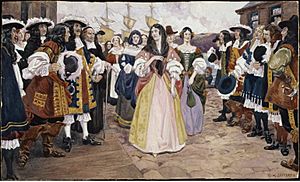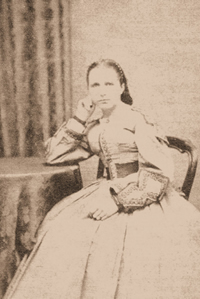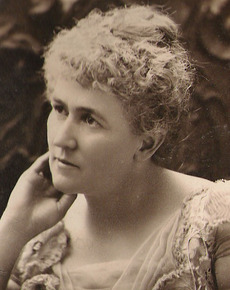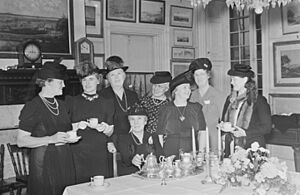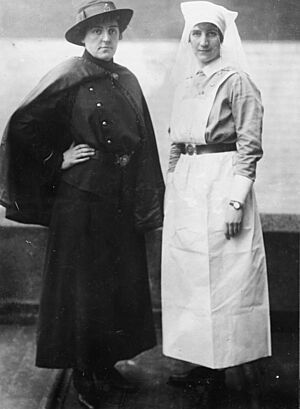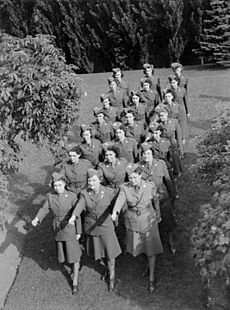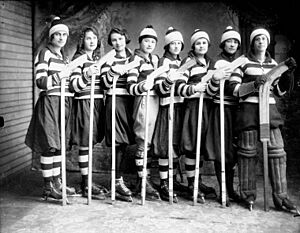History of women in Canada facts for kids
| General Statistics | |
|---|---|
| Maternal mortality (per 100,000) | 7 |
| Women in parliament | 28.3% |
| Women over 25 with secondary education | 100.0% |
| Women in labour force | 74% [M: 81%] |
| Gender Inequality Index | |
| Value | 0.069 (2021) |
| Rank | 17th out of 191 |
| Global Gender Gap Index | |
| Value | 0.777 (2022) |
| Rank | 24th out of 146 |
The history of women in Canada explores the lives of women in Canada through time. It also looks at the laws and rules that have affected them. In early Canadian history, Indigenous women's roles changed when Christian missionaries arrived. Their marriages to European fur traders also connected their communities to the outside world.
During the colonial period, European women were encouraged to move to Canada. This helped the population grow. After Canada became a country in 1867, women's lives were shaped by laws from the federal government and provinces. Women have always been important in Canada's workplaces, social movements, and culture. However, they have also faced unfair treatment.
Women gained the right to vote in federal elections in 1918. They served in both the First World War and the Second World War. From the 1960s, they joined the second-wave feminist movement. Historians have been studying and writing about women's history in Canada more and more since the 1960s.
Contents
- Women in Quebec
- Women in the Maritimes
- Women in Ontario
- Women in the Prairie Provinces
- Indigenous Women
- Employment for Women
- Upper Classes in the 19th Century
- Women's Clubs
- Women and Labour Unions
- Feminism and Women's Right to Vote
- Women in the First World War
- Women in the Second World War
- Women in Sports
- Historiography and Recognition
- See also
Women in Quebec
In the 1660s, the French government sent about 800 young women to Canada. They were called King's Daughters ("filles du roi"). These women were single or widowed. They quickly found husbands among the many male settlers. They also started new lives for themselves.
Most of them came from poor families in France. As farm wives, they ate well and had many children. They played a big part in starting families and helping the population grow fast. They had about 30% more children than similar women who stayed in France. People in Canada had a great diet for their time. This was because of plenty of meat, fish, and clean water. Food also kept well in winter, and there was enough wheat most years.
Besides housework, some women worked in the North American fur trade. This was the main way to earn money in New France. They worked at home with their husbands or fathers as merchants and suppliers. Some women who became widows took over their husbands' businesses. A few were successful business owners on their own.
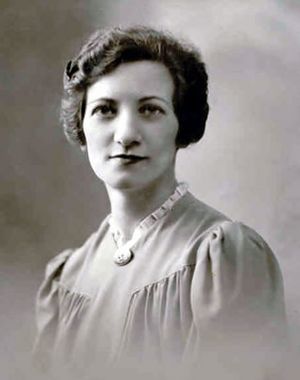
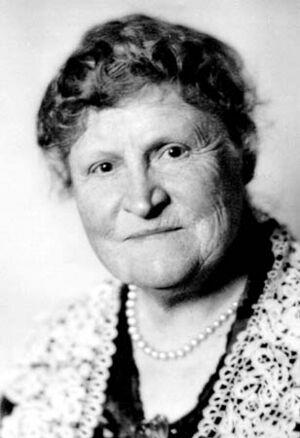
In the early 1800s until the 1950s, wealthy English-speaking women led high society in Montreal. They used social events, like debutante balls, to show their identity and social status. These young women were taught to be generous and responsible citizens. They often did this through groups like the Junior Leagues. They usually did not connect with the ideas of middle-class women who wanted reforms. They also had old-fashioned views about what working-class women needed.
Catholic Nuns and Their Role
Outside the home, Canadian women had few areas they controlled. A big exception was Roman Catholic nuns, especially in Quebec. New groups for women started in the 1600s. They were inspired by religious movements in France. Over the next three centuries, women opened many independent religious orders. These were partly funded by money given by the parents of young nuns.
These orders focused on helping others. They ran hospitals, orphanages, homes for single mothers, and schools. In the first half of the 1900s, about 2-3% of young women in Quebec became nuns. There were 6,600 nuns in 1901 and 26,000 in 1941. In Quebec in 1917, 32 different teaching orders ran 586 boarding schools for girls. At that time, there was no public education for girls in Quebec after elementary school. Hospitals were another special area for nuns. The first one was founded in 1701. By 1936, Quebec nuns ran 150 institutions. These had 30,000 beds for the sick, homeless, and orphans. Catholic nuns also ran similar, smaller institutions in other provinces.
The Quiet Revolution in the 1960s brought big changes. Many nuns left their convents, and very few young women joined. The provincial government took over the nuns' traditional role of providing education and social services. Often, former nuns continued the same work as civilians. However, men also started working in teaching for the first time.
Marriage and Family Law in Quebec
In Quebec, women's rights in marriage and family law grew slower than in the rest of Canada. Quebec was slow to give civil rights to married women. Until 1954, a married woman was legally seen as "unable to make contracts." This was the same as minors and people with mental health issues. Removing married women from this list did not improve their legal situation much. Marriage laws still limited their rights and gave husbands legal power over them.
A big change happened in 1964 with Bill 16. This law removed the wife's duty to obey her husband. It gave married women full legal power, with some limits based on their marriage agreement. However, unfair rules from marriage agreements and other laws still remained. In July 1970, Bill 10 came into effect. This law reformed marriage agreements and made things better for married women.
In 1977, another important change happened. Wives gained equal rights with husbands over their children during marriage. This ended the old rule of 'paternal authority,' which gave husbands more legal rights in court matters about children. The new law created the idea of parental authority shared equally by both parents. A major change also came in April 1981. New family rules based on gender equality became law.
Other reforms followed in the 1980s. This included the idea of family property in 1989. This was to make sure spouses had equal money when a marriage ended. On January 1, 1994, the new Civil Code of Quebec started. This new code has Quebec's current family law. It is based on gender equality. Article 392 says: "The spouses have the same rights and obligations in marriage."
Because of its Catholic background and the church's strong influence, Quebec was very slow to accept divorce. Until 1968, Canada did not have one federal divorce law. Quebec had no divorce law, and couples could only end their marriage if Parliament passed a special law for them. Since 1968, divorce law across Canada is controlled only by the federal Parliament. The current law is the Divorce Act (Canada) 1985, which started in June 1986.
Women in the Maritimes
In the 1800s, middle-class English-speaking women across Canada, especially in the Maritime provinces, changed how they decorated their homes. Instead of plain, useful items, they made their living spaces lively. They used soft furniture, thick carpets, handmade crafts, hanging plants, and inexpensive paintings. They got their ideas from ladies' magazines and from each other. They were taking more control of their home, which they made into a cozy escape from the busy business world of men.
From the late 1800s to the Great Depression, thousands of young, single women from the Maritimes moved to New England. They found better-paying jobs there. Their families needed the money. Most worked as house servants or in textile mills and shoe factories. After 1900, some became professionals, especially teachers and nurses. Most returned home to get married.
Some women in the Maritimes worked in jobs mostly done by men, like seafaring. More women went to sea in the 1800s. However, they usually worked in traditional roles like stewardesses. Bessie Hall from Granville Ferry, Nova Scotia learned to navigate ships. She took command of a sick ship in the 1870s. But she left the sea because women were not allowed to be officers. Molly Kool of Alma, New Brunswick, broke barriers against women at sea in 1938. She became the first woman in the Western world to earn her captain's licence.
While New Brunswick gave women the right to vote in 1919, women in this province could only hold political office starting in 1934.
Women in Ontario
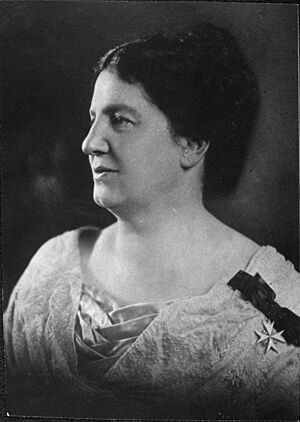
Caring for children born outside of marriage was a high priority for private charities. Before 1893, the Ontario government gave money to charities that ran homes for babies and their nursing mothers. Most of these babies were born outside of marriage, and most of their mothers were poor. Many babies arrived in poor health, and their chances of survival outside these homes were low.
Ontario's Fair Employment Practices Act fought against unfair treatment based on race and religion after the Second World War. However, it did not cover gender issues. Most human rights activists did not bring up this issue before the 1970s. This was because they believed in the idea of a "family wage." This meant the husband should earn enough money so the wife could be a full-time homemaker.
After women, labor unions, and the Co-operative Commonwealth Federation (CCF) pushed for change, the Conservative government passed the Female Employees Fair Remuneration Act in 1951. This law required equal pay for women who did the same work as men. In the 1950s and 1960s, feminists tried to get a law that would stop other types of gender unfairness, like in hiring and promotions. But they were not successful. The laws that were passed were not strongly enforced. Government officials interpreted the equal pay act very strictly. They were much more active in fighting unfair treatment based on race and religion in jobs.
Women in the Prairie Provinces
Gender roles were very clear in Western Canada. Men were mainly responsible for clearing land, planting, harvesting, building homes, and handling money. At first, there were many single men on the prairie, or husbands whose wives were still back east. They found it hard to manage. They realized they needed a wife.
As the population grew quickly, wives played a key role in settling the prairie region. Their hard work, skills, and ability to adapt to the tough environment were crucial. They made bread, cooked beans and bacon, mended clothes, raised children, cleaned, tended gardens, sold eggs and butter, helped at harvest time, and nursed everyone back to health. Even though old-fashioned ideas and laws often overlooked women's contributions, their flexible work was vital for family farms to survive. This also helped the success of the wheat economy.
Indigenous Women
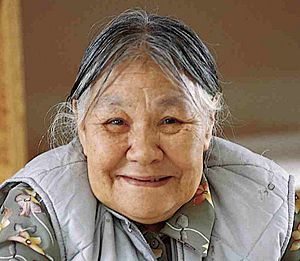
There have been few detailed studies about Indigenous women. In the 1900s, Native Homemakers' Clubs became very important for women in First Nation communities. They first started in Saskatchewan in 1937. These clubs helped Indigenous women get education, take action, and have a voice. The Department of Indian Affairs (DIA) encouraged these clubs to grow. By 1955, there were 185 of them.
Employment for Women
In early 1800s cities, most women were homemakers. However, some worked, mainly as house servants, unskilled laborers, nuns (in Catholic areas), and teachers. A few were governesses, washerwomen, midwives, dressmakers, or innkeepers. Most Canadian women lived in rural areas. They worked at home or as domestic servants until they married and became homemakers. British women, like Maria Rye, created groups to help girls and women move to Canada.
Domestic Servants
From the late 1800s to 1930, 250,000 women moved from Europe, especially Britain and Ireland. Middle-class homemakers eagerly hired domestic workers, many of them Irish. As middle-class incomes rose, there was a growing need for servants, more than the local supply. However, many servants soon married, so there was a high turnover.
Business Owners
In the 1800s, few women owned businesses or worked in professions like law and medicine on their own. However, many worked closely with their husbands, fathers, brothers, and sons in shops and stores. Changes to married women's property law in the 1800s made it legally possible for wives to run businesses independently. But in reality, courts often saw the wife as a dependent partner. She owed her work mainly to her husband. So, most women who ran businesses were widows who had inherited their husband's business.
Nursing and Medicine
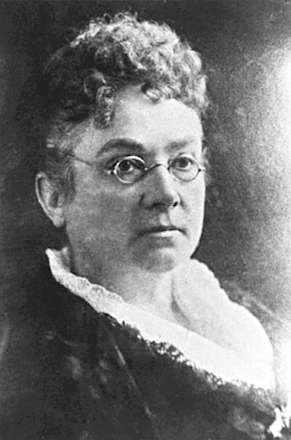
In the late 1800s and early 1900s, women started working in various professions. These included teaching, journalism, social work, and public health. Nursing was already well-established. These advances included opening a Women’s Medical College in Toronto (and Kingston, Ontario) in 1883. This was partly due to the hard work of Emily Stowe, the first female doctor to practice in Canada. Stowe’s daughter, Augusta Stowe-Gullen, was the first woman to graduate from a Canadian medical school.
Graduating from medical school did not always mean women could get a license. Elizabeth Scott Matheson graduated in 1898. But the Northwest Territories College of Physicians and Surgeons refused to give her a license. The government hired her as the district doctor for $300 a year in 1901. She finally got her license in 1904.
Except for a very few, women were outsiders in the male-dominated medical field. As doctors became more organized, they successfully passed laws to control medicine and pharmacy. These laws banned traditional healers. Midwifery—practiced by women—was restricted and almost disappeared by 1900. Even so, most births happened at home until the 1920s. Then, hospitals became preferred, especially by women who were more educated and trusted modern medicine.
Healthcare in the Prairies

In the Prairie provinces, early settlers had to provide their own medical care. Poverty and being far from towns meant women learned and practiced medicine. They used herbs, roots, and berries that their mothers had used. They prayed for help and also used traditional magic. This gave them psychological comfort. People continued to rely on homeopathic remedies. Trained nurses and doctors, and how-to manuals, slowly reached the homesteaders in the early 1900s.
After 1900, medicine and especially nursing became modern and well-organized. The Lethbridge Nursing Mission in Alberta was a typical Canadian volunteer mission. It was founded in 1909 by Jessie Turnbull Robinson, separate from the Victorian Order of Nurses. Robinson, a former nurse, was elected president of the Lethbridge Relief Society. She started nursing services for poor women and children. A volunteer board of women directors ran the mission. They raised money through donations and payments from the Metropolitan Life Insurance Company. The mission also combined social work with nursing, helping to give out unemployment relief.
In Alberta, there were differences between the Alberta Association of Graduate Nurses (AAGN), started in 1916, and the United Farm Women of Alberta (UFWA), started in 1915. They disagreed about whether to make midwifery a recognized part of nursing. The UFWA leaders said the AAGN ignored the medical needs of rural women. They worked to improve the lives of women farmers. Irene Parlby, the UFWA's first president, pushed for a provincial Department of Public Health. She also wanted government hospitals and doctors, and a law allowing nurses to become registered midwives.
The AAGN leaders were against certifying midwives. They argued that nursing training did not include midwifery, so nurses were not qualified for home births. In 1919, the AAGN and UFWA reached an agreement. They worked together to pass the Public Health Nurses Act. This law allowed nurses to work as midwives in areas without doctors. So, Alberta's District Nursing Service, created in 1919, was mainly due to the organized efforts of UFWA members. It was less due to professional nursing groups, who were not very interested in the medical needs of rural Canadians.
The Alberta District Nursing Service provided healthcare in mostly rural and poor areas of Alberta in the first half of the 1900s. It was founded in 1919 by the United Farm Women (UFWA) to help with maternal and emergency medical needs. The Nursing Service treated prairie settlers in remote areas without doctors or hospitals. Nurses provided prenatal care, worked as midwives, did minor surgery, checked schoolchildren's health, and ran immunization programs. After the Second World War, large oil and gas discoveries brought wealth. This led to more local medical services. Provincial health and universal hospital insurance laws in 1957 led to the end of the District Nursing Service in 1976.
Women in Military Services
Over 4,000 women served as uniformed nurses in the Canadian Armed Forces during the Second World War. They were called "Nursing Sisters." They had already been trained as nurses in civilian life. In military service, they gained a high status, much better than their civilian jobs. Nursing Sisters had more responsibility and freedom. They also had more chances to use their skills than civilian nurses. They were often close to the front lines. Military doctors, mostly men, gave nurses a lot of responsibility. This was because of many injuries, few doctors, and tough working conditions.
Upper Classes in the 19th Century

Most upper-class Canadians, except for some French families in Quebec, were of British origin. Military and government officials and their families came to British North America from England, Scotland, or Ulster. Most businesses were controlled by men of British descent. French-Canadians mostly remained culturally separate from English-speaking Canadians. This situation was later described in Two Solitudes by Hugh MacLennan.
English-speaking Canadian writers became popular. These included Catharine Parr Traill and her sister Susanna Moodie. They were middle-class English settlers who wrote about their difficult lives as pioneers. Traill published The Backwoods of Canada (1836) and Canadian Crusoes (1852). Moodie published Roughing it in the Bush (1852) and Life in the Clearings (1853). Their stories told of the harshness of life for women settlers, but they were still popular.
Upper-class Canadian women copied British culture. They brought as much of it as possible across the Atlantic. Books, magazines, popular music, and theatre shows were all imported to meet women's demand.
Upper-class women supported charity causes. These were similar to the education and nursing charities supported by wealthy women in England. The Victorian Order of Nurses, which still exists, was founded in 1897. It was a gift to Queen Victoria to celebrate her Diamond Jubilee. The Imperial Order of the Daughters of the Empire, founded in 1900, supports scholarships and book awards. These promote Canadian patriotism and knowledge of the British Empire.
One of the supporters of Halifax's Victoria School of Art and Design (founded in 1887 and later named the Nova Scotia College of Art and Design) was Anna Leonowens. Women began to make progress in getting access to higher education. In 1875, the first woman to graduate from a Canadian university was Grace Annie Lockhart (Mount Allison University). In 1880, Emily Stowe became the first woman licensed to practice medicine in Canada.
Women's Clubs
Women gained the right to vote during World War I. Efforts for women's voting rights began in the late 1800s. In 1883, the Toronto Women's Literary and Social Progress Club met. They then formed the Canadian Women's Suffrage Association.
Woman's Christian Temperance Union (WCTU)
Before the 1870s, there were few groups for women. Most were charity groups linked to churches and controlled by male leaders. A big change came with the Woman's Christian Temperance Union (WCTU) in the 1870s. This movement started in Ohio and quickly spread worldwide. It began a chapter in Ontario in 1874 and became a national union in 1885. By 1914, it had 16,000 members across Canada.
Their main goal was prohibition. This was a law to stop the sale of alcohol. They wanted to reduce the power of alcohol businesses, lower violence among men, reduce violence towards wives and children, and keep more money in families. Most leaders came from Protestant churches, especially Methodists and Baptists. Episcopalians rarely joined, and Catholics almost never did. They believed that churches, not private groups or the government, should control society.
The WCTU led the fight for women's votes. Their argument was based on a maternal feminist idea. They believed women had higher moral standards, especially for home and family life. They needed votes to make sure the government supported good public morals. In this view, women were seen as a positive influence on society. This was a big part of women's work in missionary groups and the WCTU.
Starting in the late 1870s, the Ontario WCTU demanded that schools teach "scientific temperance." This taught moral lessons about temperance along with anatomy and hygiene. It was meant to be a required subject. At first, they convinced the Ontario Department of Education to adopt it. But teachers were against the plan and refused to teach it. The WCTU then tried to make the province alcohol-free through government action. They started with "local option" laws. These allowed local governments to ban alcohol sales. Many towns and rural areas became "dry" before 1914, but larger cities did not.
The WCTU always supported prohibition and women's right to vote. But they also had other goals. For example, the Alberta WCTU focused on prohibition, women's suffrage, and temperance education. Their leader was Nellie McClung (1873–1951). She was a popular writer and social activist. She led the fight for women's right to vote in Alberta and Canada. In 1921, she was elected to the Alberta legislature. Meanwhile, the Saskatchewan group focused on charity work. This was due to their leaders' interests, immigration, rural needs, and their belief in Saskatchewan's "farming future." Many chapters were involved in campaigns to restrict smoking and ban cigarettes between 1892 and 1914.
Local Women's Clubs
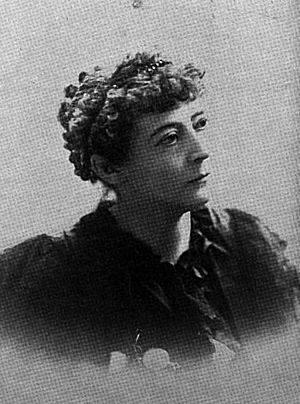
The Calgary Current Events Club started in 1927 with seven women. It quickly became popular with professional women in the city. In 1929, the group changed its name to the Calgary Business and Professional Women's Club (BPW). This was in response to a call for a national group of such clubs. Members traveled to London, England in 1929. They argued for women to be recognized as full legal citizens.
In the 1930s, the group discussed many important political issues. These included a minimum wage, fair unemployment insurance, required medical exams for schoolchildren, and a medical certificate for marriage. The national BPW meeting was held in Calgary in 1935. The club actively supported Canadian forces overseas in the Second World War. At first, most members were secretaries and office workers. More recently, it has been led by executives and professionals. The organization continues to work on women's economic and social issues.
Lauretta Hughes Kneil was an active leader in Edmonton from 1909 to 1923. Her work in the Catholic Women's League and the local chapter of the National Council of Women of Canada taught her about civic affairs, public speaking, and talking to government. This helped her charity work. Kneil was appointed to the Board of Public Welfare in 1914. She became a provincial factory inspector in 1917. She also helped promote the Mothers' Allowance Act of 1919.
Women journalists formed the Canadian Women's Press Club (CWPC). They demanded free railway passes to cover the 1904 World's Fair in St. Louis, Missouri. It had local chapters in major cities and was later renamed the Media Club of Canada. The first president of the CWPC was Kit Coleman (1864–1915). Her pen name was Kathleen Blake Coleman. Born in Ireland, Coleman was the world's first accredited female war correspondent. She covered the Spanish–American War for The Toronto Mail in 1898. Ella Cora Hind (1861–1942) was Western Canada's first woman journalist and a women's rights activist.
Women and Labour Unions
In Nova Scotia, United Mine Workers took control of the coal miners in 1919. Women played an important, though quiet, role in supporting the union movement in coal towns during the difficult 1920s and 1930s. They never worked in the mines. But they gave emotional support, especially during strikes when there was no pay. They managed family money and encouraged other wives. These wives might otherwise have pushed their husbands to accept company terms.
Women's labor leagues organized social, educational, and fundraising events. Women also strongly confronted "scabs" (workers who crossed strike lines), policemen, and soldiers. They had to make food money stretch and be creative in clothing their families.
Feminism and Women's Right to Vote
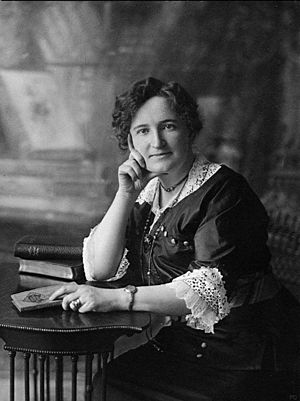
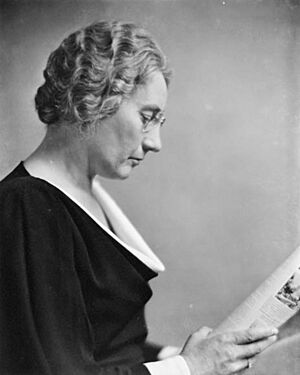
The first wave of feminism began in the late 1800s. Women's legal rights slowly improved throughout the 1800s. In 1859, Upper Canada passed a law allowing married women to own property. In 1885, Alberta passed a law allowing unmarried women who owned property the right to vote and hold office in school matters.
This early activism focused on increasing women’s role in public life. Goals included women’s right to vote, more property rights, better access to education, and being recognized as "persons" under the law. This early Canadian feminism was largely based on maternal feminism. This was the idea that women are natural caregivers and "mothers of the nation." They should take part in public life because they are seen as naturally making decisions that will benefit society. In this view, women were seen as a civilizing force. This was a big part of women’s involvement in missionary work and the Woman’s Christian Temperance Union (WCTU).
Religion was important in the early stages of the Canadian women’s movement. Some of the first organized women's groups came together for religious reasons. When churches and missionary groups rejected women as missionaries, they started their own missionary societies. They raised money to send female missionaries abroad. Some raised enough to train their missionaries as teachers or doctors.
The National Council of Women of Canada strongly promoted women's political status without the vote from 1894 to 1918. It promoted a vision of "transcendent citizenship" for women. They believed voting was not needed. Instead, citizenship could be shown through personal influence and moral persuasion. This meant electing men with strong moral character and raising public-spirited sons. The National Council's view was part of its nation-building plan. This plan aimed to keep Canada as a white settler nation. While the women's right to vote movement was important for white women, it also used arguments based on race. These linked white women getting the vote to the need to protect the nation from "racial decline."
Women sometimes had a local vote in some provinces. For example, in Ontario from 1850, women who owned property could vote for school trustees. By 1900, other provinces adopted similar rules. In 1916, Manitoba led the way by giving women full voting rights. At the same time, women who wanted the right to vote strongly supported the prohibition movement, especially in Ontario and the Western provinces.
The Military Voters Act of 1917 gave the vote to Canadian women who were war widows or had sons or husbands serving overseas. Unionists Prime Minister Sir Robert Borden promised equal voting rights for women during the 1917 election campaign. After his big win, he introduced a bill in 1918 to give women the right to vote. This passed easily, but it did not apply to Québec. Women in Québec did not get full voting rights until 1940. The first woman elected to Parliament was Agnes Macphail in Ontario in 1921.
| Province | Date of Women's Suffrage | Date of Women's Ability to Hold Office |
|---|---|---|
| Manitoba | January 28, 1916 | January 28, 1916 |
| Saskatchewan | March 14, 1916 | March 14, 1916 |
| Alberta | April 19, 1916 | April 19, 1916* |
| British Columbia | April 5, 1917 | April 5, 1917 |
| Ontario | April 12, 1917 | April 24, 1919 |
| Nova Scotia | April 26, 1918 | April 26, 1918 |
| New Brunswick | April 17, 1919 | March 9, 1934 |
| Prince Edward Island | May 3, 1922 | May 3, 1922 |
| Newfoundland | April 13, 1925 | April 13, 1925 |
| Quebec | April 25, 1940 | April 25, 1940 |
| Dominion of Canada (federal government) | Relatives of individuals in the armed forces – September 20, 1917. All female British subjects in Canada, May 24, 1918 | July 7, 1919** |
- The first women elected in the British Empire were two Alberta women (Louise McKinney and Roberta MacAdams) elected in 1917.
- The first woman elected to the House of Commons was Progressive candidate Agnes MacPhail, elected in 1921.
Women in the First World War
The First World War created many new chances for women to work and volunteer. They took care of families and kept spirits up while many men were away. About 3,411 women became nurses serving in uniform. When war started, Laura Gamble joined the Canadian Army Medical Corps. She knew her experience in a Toronto hospital would help the war effort.
Healthcare workers had to deal with new medical problems they had never seen before. Poison gas caused injuries for which treatments had not yet been developed. The only thing that helped Canadian soldiers affected by the gas was the constant care from nurses.
On the Canadian home front, women could help the war effort in many ways. Lois Allan joined the Farm Services Corps in 1918. She replaced men who went to the front. Allan worked at E. B. Smith and Sons, where she hulled strawberries for jam. Jobs also opened up in factories as industrial production increased. Women worked ten to twelve hours a day, six days a week. Because the work was long and repetitive, many women made up funny versions of popular songs to get through the day and boost morale. Depending on the area, some women could choose to sleep in barracks or tents at the factory or farm where they worked.
A brochure from the Canadian Department of Public Works listed several areas where women could work:
- On fruit or vegetable farms.
- In camps to cook for workers.
- On mixed and dairy farms.
- In farmhouses to help feed those raising crops.
- In canneries to preserve fruit and vegetables.
- To take charge of milk routes.
Many women also joined charity groups, like the Ottawa Women’s Canadian Club. These groups helped provide for soldiers, their families, and war victims. Women were called "soldiers on the home front." They were encouraged to use less or nothing and to save supplies for the war effort.
Women in the Second World War
The Canadian Women's Auxiliary Air Force (CWAAF) was formed in 1941. It was part of the Royal Canadian Air Force. It changed to the Women's Division (WD) in 1942. This unit was created to fill jobs that would let more men fight and train. WD members worked as clerks, drivers, hairdressers, hospital assistants, and photographers. They also worked as intelligence officers, instructors, and wireless operators. Although the Women's Division ended in 1946, women were not allowed to join the RCAF again until 1951.
The Women's Royal Canadian Naval Service (WRCNS) was part of the Royal Canadian Navy. It was active during the Second World War and after. This unit was part of the Royal Canadian Naval Reserve until the forces combined in 1968. The WRCNS (or Wrens) was based on the Women's Royal Naval Service in Britain. That group had been active in the First World War and brought back in 1939. The Royal Canadian Navy was slow to create a women's service. It started the WRCNS in July 1942, almost a year after the Canadian Women's Army Corps and the Royal Canadian Air Force Women's Division. By the end of the war, almost 7,000 women had served with the WRCNS in 39 different jobs.
The Canadian Women's Army Corps was a non-fighting part of the Canadian Army. It was set up during the Second World War to free up men from non-fighting roles. This helped Canada's war effort. Most women served in Canada. But some served overseas, mostly as secretaries, mechanics, and cooks. The CWAC was finally ended as a separate group in 1964. At that time, women were fully included in the Canadian armed forces.
Women's military involvement opened the way for women to be in fighting roles later. Tens of thousands of women joined these groups. This gave Canadian women a chance to help in a global conflict. Their help was vital for the Allied victory. However, it did not change the power balance in Canada regarding military involvement. Sexism returned strongly after the Second World War. Women in Canada and worldwide were pushed back into their homes and kitchens. Women joining the army in World War II did not change the power balance between genders in Canada.
The freedom women felt during the war was over. It was time to return to their "normal" and "proper" home duties. The Second World War gave women the first big chance to leave their parents', husbands', and children's homes. They could work for pay. This had never happened on such a large scale for women before. This mass movement of women from Canadian homes allowed them to create new identities. They became military service women and factory workers. This was because they could now earn a paycheck doing public work.
Women in Sports
Sports are very important in Canadian culture. But women were long treated as second-class. There were also regional differences. Eastern provinces preferred a more "feminine" basketball game for girls. Western provinces preferred the same rules for everyone. Girls' and women's sports have traditionally faced challenges. Girls and women historically had low interest and participation. There were very few women in leadership roles in schools or sports. There were few women coaches. The media strongly focused on men's sports. This suggested that women seriously interested in sports were crossing gender lines. The male sports world was often against women's sports. And strong feminists sometimes thought sports were not important enough to support.
Women's progress was hard. First, they had to fight the common idea that women's bodies were too weak for strong physical activity. These ideas were first challenged by the "new woman" around 1900. These women started with bicycling. They rode into new areas for women in education, work, and voting rights.
The 1920s was a breakthrough for women. This included working-class young women, not just the pioneering middle-class sportswomen. The Women's Amateur Federation of Canada (WAAF) was formed in 1926. It aimed to create new opportunities, especially in international competitions. The WAAF worked to prove wrong the idea that strong physical activity and intense competition were "unwomanly." One way they did this was by setting up medical checks for all women athletes. The WAAF worked with supportive men who led the Amateur Athletic Union of Canada. This allowed women to compete in the Olympics and the British Empire Games.
Many barriers fell in the 1920s. The Edmonton Grads became world champions in women's basketball. The first Canadian women competed in the Olympics. And women sportswriters, like Phyllis Griffiths, were hired to cover their achievements.
The 1930s brought setbacks. Critics suggested non-competitive activities were best for women. During the 1930s, a team of women from Preston, Ontario, faced challenges. They had trouble getting enough ice time for practice and raising money from their small fan base. Despite this, the Rivulettes dominated women's ice hockey. They won ten provincial championships and four of six national championships. With money short during the Great Depression, and then the Second World War's focus on men, women's opportunities decreased after 1939. Women's hockey mostly disappeared during the war. After the war, the focus on families pushed women's sports into the background. The feminists of the 1970s rarely helped promote women's breakthroughs in sports.
Still, more and more women took part in aerobics and organized sports. Figure skater Barbara Ann Scott was the top female athlete of the 1940s. She was the 1948 Olympic champion, a two-time World champion (1947–1948), and a four-time Canadian national champion (1944–46, 48). The media covered her a lot. However, they focused less on her sportsmanship and achievements. Instead, they focused more on her beauty and "sweetheart" image.
Change for women in sport started slowly but sped up after 1980. The Fitness and Amateur Sport Act of 1961 and the Royal Commission on the Status of Women report in 1970 were big steps forward. Perhaps the most important event was in 1974. Marion Lay and the federal government’s Fitness and Amateur Sport Branch (FASB) held a National Conference on Women and Sport. It brought together coaches, school leaders, and athletes. They talked about issues raised by the Royal Commission and planned for the future. Even so, there was no way to track progress or make sure recommendations were followed.
The 1980s saw faster progress. This included Sport Canada’s Women’s Program in 1980, the Female Athlete Conference in 1981, the Women in Sport program in 1981, and the Constitution Act of 1982. In 1981, Abby Hoffman, a former Olympian, became director general of Sport Canada. Its "Policy on Women's Sport" called for equality. The AAU of Canada became more supportive. Court cases confirmed women's right to participate. In the provinces, human rights commissions handled many sport-related fairness cases for women. Gender barriers in sports became a political topic. This was shown by the Minister’s Task Force Report in 1992. Also, the Canadian Sport Council made a landmark decision to include gender equality goals in their rules.
By the 1990s, women were eager to join sports that used to be only for men. These included ice hockey, rugby, and wrestling. Their activism and skill on the field broke old stereotypes. They opened up new social roles for women athletes in schools and communities. New challenges arose for sportswomen trying to be equal with sportsmen. These included raising money, attracting audiences, and finding sponsors.
The growth of women's sports in higher education from 1961 to 2001 has been studied. The National Fitness and Amateur Sport Advisory Council helped women's university sports gain momentum. At the same time, more women were attending universities, which made their sports more visible. To overcome resistance, women focused on organizing their sports and raising awareness among both male and female students. In 1969, the Canadian Women's Intercollegiate Athletic Union was formed. It oversaw events and approved national championships. It merged with the Canadian Intercollegiate Athletic Union in 1978. Women became more active after 1980.
Historiography and Recognition
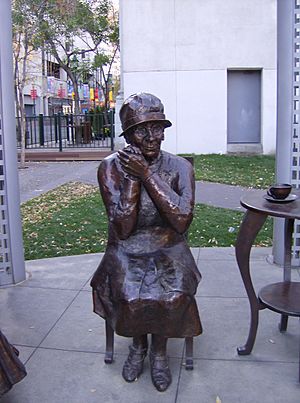
The women's history movement began in the 1970s. It grew quickly across Canadian universities. It gained support from history departments and other subjects. The Canadian Committee on Women's History (CCWH) was founded in 1975. Franca Iacovetta reported in 2007:
Although the most prestigious awards and endowed chairs still go mostly to men, and men still outnumber women at the full professor rank, the greater influence of feminist historians within the wider profession is evident in their increased presence as journal and book series editors, the many scholarly prizes, the strong presence of women's and gender history on conference programs, and the growing number of their students who are in full-time positions.
—Franca Iacovetta
Memorials
A memorial in Salmon Arm, British Columbia, was dedicated on August 14, 2000. It honors all Canadian women who served in the First and Second World Wars and the Korean War.
A 6'4" high bronze statue called "Canadian Women’s Army Corps" (2000) by André Gauthier (sculptor) stands in front of the Kitchener Armoury in Kitchener, Ontario. It honors the women who served in the Canadian Women's Army Corps between 1941 and 1945. It also lists those who died while serving.
A bandstand in Veterans Memorial Park in Langford, British Columbia, was dedicated in 2001. It honors all Canadian Women Mariners who served their country in wartime. A plaque lists eight of these brave women who were killed in action.
The first public monument built for a woman in Canada was in 1870 in Pugwash, Nova Scotia. The Legislature of Nova Scotia put it up. The Crowley Memorial remembers the heroic death of Mary Elizabeth Crowley. She died on October 15, 1869, at age 12. She had saved her younger brother and sister from her parents' burning home.
See also
- Catholic sisters and nuns in Canada
- History of American women
- History of women in the United Kingdom
- Women in the Victorian era#Canada
- Women in Canadian politics


